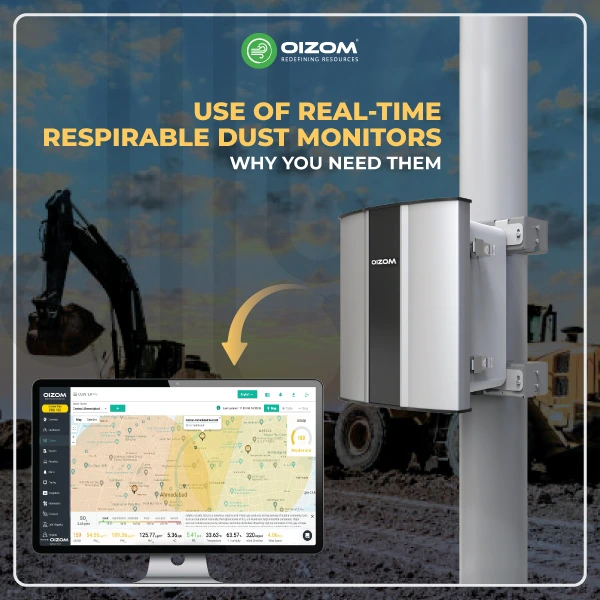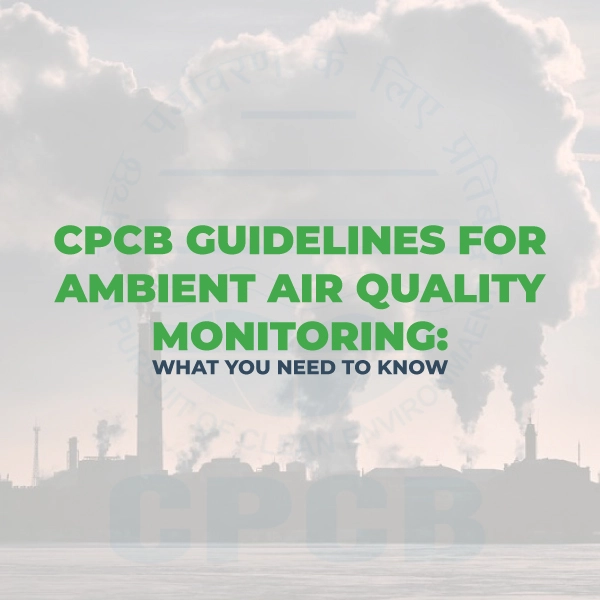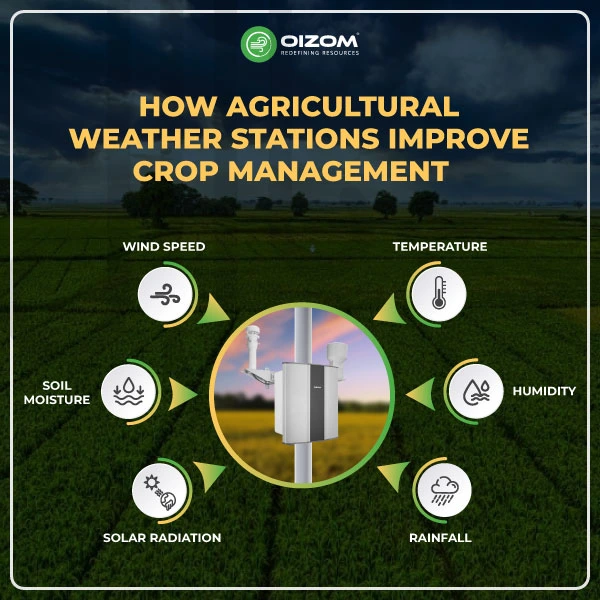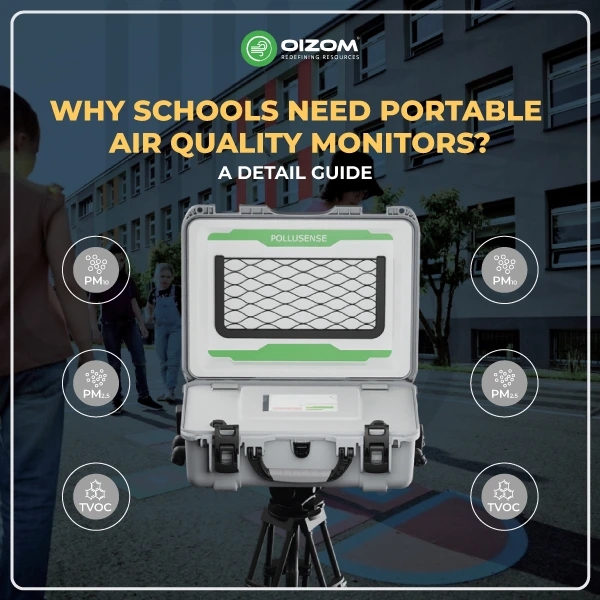Key Takeaway Points:
- Hidden Dust Risks: Many industries, like mining and construction, have invisible airborne dust hazards, and the smallest particles are the most dangerous to health.
- Real-time Dust Monitoring: Unlike outdated methods, real-time monitors provide instant data, allowing businesses to take quick action to protect workers and the environment.
- Advanced Technology: Modern dust monitors, like Dustroid, use light scattering technology to measure the size and quantity of dust particles in real-time.
- Components of Monitoring System: These systems include sensors, data processors, displays, and cloud platforms for seamless monitoring, storage, and analysis.
- Portable vs. Fixed Monitors: Portable monitors are ideal for temporary mobile monitoring, while fixed monitors offer long-term, continuous data collection at designated locations.
- Real-time vs. Gravimetric Monitors: Real-time monitors give instant results using sensors, while gravimetric monitors capture large volumes of dust for detailed lab analysis.
- Applications Across Industries: Industries like construction, mining, manufacturing, and urban settings rely on dust monitors to comply with health regulations and ensure safety.
- Instant Alerts and Data Analysis: These systems provide real-time alerts for immediate corrective actions and offer detailed historical data analysis tools.
- Durability: Devices like Dustroid are built to withstand harsh environmental conditions with weather-resistant enclosures, ensuring long-lasting performance.
- IoT Integration: Leveraging IoT platforms and dust monitors enables businesses to monitor and manage air quality remotely and in real-time, improving health, safety, and environmental outcomes.
The Use of Real-time Respirable Dust Monitors: Why You Need Them
Almost any workplace or industry, including mining, construction, and manufacturing, can have hidden health risks from airborne particles and dust. The tricky part is these dust risks aren’t always visible, and it’s often the tiniest particles that cause the most harm. These small particles can make their way deep into the lungs, posing serious health threats. Did you know that not all dust is created equal? Depending on its size and composition, dust can pose varying degrees of health risks. This is where air quality monitors come into the picture. Real-time respirable dust monitors play a vital role in ensuring safe environments, particularly in industries like mining, construction, and manufacturing.
Due to its multifaceted advantages, real-time dust monitoring has gained significant importance. This blog will explore its use, how it measures respirable dust, the device’s key components, and various applications. Let’s dive in!
Did you know this? In 2023, the global market for dust monitors was valued at around $763.6 million, and it’s expected to grow to $1,153.7 million by 2030, with an annual growth rate of 6% between 2024 and 2030. North America leads the market, holding about 35% of the share, followed by Europe with around 28%.
How it Measures Respirable Dust
Previously, dust was frequently measured at the site border using a low-cost binding agent pad gauge. However, this method is considered low-tech and unreliable because the data presented is retrospective. In contrast, today’s advanced dust monitoring solutions provide data in real time, allowing appropriate action to be taken if necessary.
Modern, innovative dust monitoring systems use superior scattered light measurement technology. These sensors emit light and detect light reflected from dust to detect extremely low amounts of dust. They can measure the size and number of dust particles in real time.
For businesses that need accurate dust monitoring, Dustroid is the perfect solution. Whether construction sites, mines, or manufacturing industry. Dustroid tracks everything from the smallest PM1 particles to the largest PM100. It is MCERTS certified. Dustroid features six months of in-device memory, ensuring continuous dust monitoring and data backup even during connectivity issues.
Key Components of the Device
The dust monitoring system comprises dust monitoring equipment and a remote monitoring cloud platform. Dust monitoring systems have various components, including the detection part, data processing, data display, and data platform.
Detection part
- Dust monitoring: It consists of PM sensors. The sensors monitor the dust continually and automatically, collecting data every minute and uploading it to the server in real time for background program statistics and analysis.
Data processing
- The data processing unit, which consists of the collection host, is the core of the dust monitoring system. It collects and stores the data monitored by the sensor. Then, it performs analysis and processing according to statistical criteria, uploads the processed data to the cloud platform, and manages the localized display of parameters to achieve a combination of environmental parameters and video surveillance images.
Data display
- An outdoor LED display panel displays real-time monitoring data on-site, warning construction units and the residents and allowing for rapid pollution management and reduction when the upper limit of dust is reached.
Data Platform
- Generally, it consists of a cloud platform for online dust monitoring. For example, Envizom is an advanced air quality monitoring software for real-time air quality data acquisition, visualization, and analytics.
- The dashboard module shows the data in different chart formats, whereas in the Overview module, the devices can be geo-mapped to their respective locations. In addition, Envizom offers advanced modules like Automated Reports, Smart Alerts, and Process Automation.
Power Supply
- Determine whether your dust monitoring requires batteries or an electrical connection. Connect the power source according to the instructions to ensure continuous operation.
Enclosure
- The Dust device has a durable, weather-resistant enclosure to withstand harsh environmental conditions. It provides long-lasting protection for the internal components against dust, moisture, and extreme temperatures.
Types of Real-time Respirable Dust Monitors
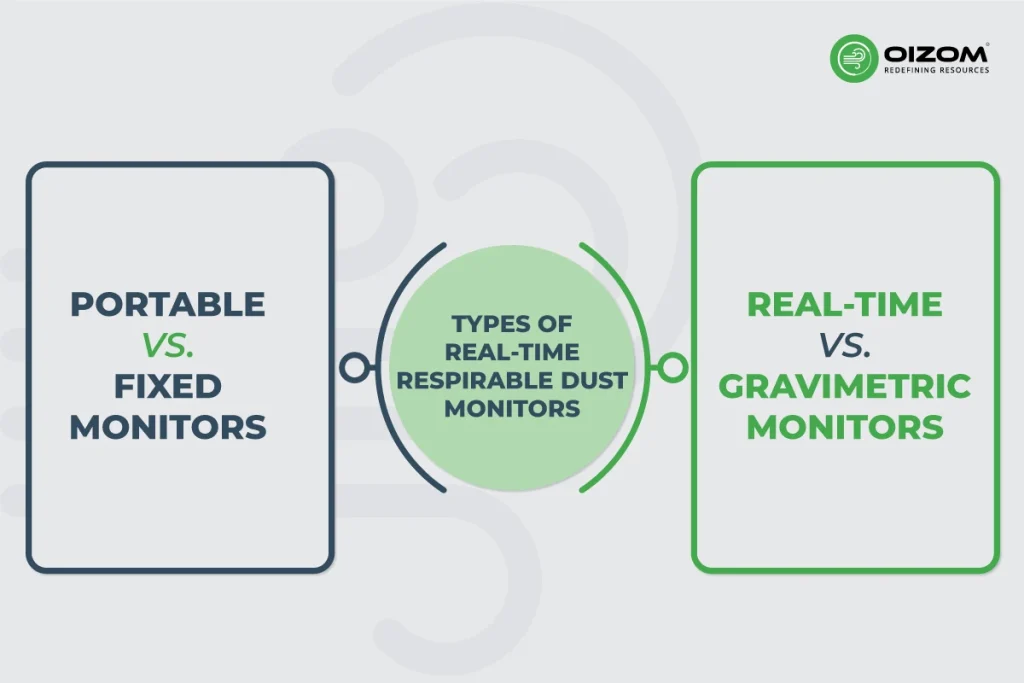
Dust monitoring is important in many industries, especially for tracking dust levels in mining and construction to ensure worker safety. There are different types of dust monitors designed to meet the needs of various industries. When it comes to real-time respirable dust monitors, there are two main types to consider: portable and fixed monitors.
Portable vs. Fixed Monitors
- Portable monitors are lightweight, easy to transport, and suitable for on-the-go monitoring in various settings, such as construction sites or field inspections. They give organizations the flexibility they need to monitor dust levels in multiple places quickly.
- Fixed monitors, on the other hand, are stationary equipment installed in specified locations to continuously monitor dust levels over time. They are ideally suited to factories, mining operations, and ports requiring regular, long-term monitoring. Fixed monitors provide reliability and the capacity to collect data continuously without the need for relocation.
Real-Time vs. Gravimetric Monitors
- Real-time dust monitors are used to measure airborne dust levels continuously, providing real-time information on the concentration of airborne particles. These are usually compact and battery-operated monitors and use active sampling technology. It uses light scattering to detect and measure dust particles in real-time. They provide instant results and are highly effective for quick decision-making.
- Oizom’s compact sensor-based real-time dust monitors provide accurate results. Dustroid measures respirable and inhalable dust, temperature, humidity, UV radiation, and ambient light. It has an IP66-grade enclosure for endurance against harsh weather conditions, which makes it capable of providing accurate data even in extreme climate conditions.
- High-volume samplers collect large quantities of airborne particles for laboratory analysis. They are ideal for use in areas with high airborne particle concentrations. They use a powerful motor to suck in large volumes of air, trapping the particles on a filter.
Applications of Real-time Respirable Dust Monitors
Almost every country has rules and regulations requiring ambient particulate monitoring in large cities. Along with government agencies, the following industries must monitor suspended particulate matter (SPM) and respirable suspended particulate matter (RSPM).
Industrial and Occupational Settings
In factories and workplaces, dust monitors help maintain air quality, ensuring compliance with health and safety regulations while protecting workers from harmful airborne particles.
Construction Sites
Construction sites can release dust and other forms of particulate matter that are harmful to inhale. Real-time monitors help manage dust exposure, ensuring a safer environment for workers and nearby residents.
Mining Operations
Mining operations generate significant dust, which poses a risk to worker health. Real-time dust monitoring helps detect and control respirable dust levels, reducing exposure and ensuring compliance with safety standards.
Manufacturing Facilities
Dust is everywhere in business, from the constant need of construction sites to the vibrating machines of manufacturing plants and even in the seemingly peaceful office surroundings where paper and machines coexist.
Environmental Monitoring
In environmental settings, real-time dust monitors are used to track particulate matter in the air, helping to detect pollution and its impact on ecosystems.
Urban Air Quality
Dust monitors are crucial in urban areas to measure air quality, providing data to address pollution control measures and ensure public health.
Benefits of Real-time Monitoring
There are various benefits of a real-time dust monitoring system, which are discussed below:
Immediate Data Collection
Dust monitoring system uses high-precision sensors to measure PM10, PM2.5, TSP, wind speed, and direction. This enables accurate real-time dust monitoring at construction sites and other industries that produce dust. The system operates continuously for 24 hours with minimal errors.
Real-time Alerts and Notifications
Dustroid keeps you updated whether you’re on-site or on the go. So, even if you’re on vacation at the beach, you can check the Oizom IoT Terminal Envizom on your phone or laptop to see the air quality at the site.
This real-time dashboard includes smart alerts that trigger automated dust mitigation solutions such as misting systems when needed. It’s not only about real-time; our in-device memory keeps data safe even during network outages.
Instantaneous Data Analysis
The cloud platform serves as the monitoring terminal for the online dust monitoring system. It can accept all data uploaded by the monitoring station, display real-time data on the platform interface as numbers or dashboards, and automatically store past data, evaluate it, and represent it as a graph. Users can see and download historical data in stages, depending on their needs.
Real-time data analysis can improve health and safety by identifying increases in dust levels and enabling timely interventions, particularly in industrial settings. Additionally, data trends can identify consistently high-level areas, allowing for targeted mitigation strategies.
Improved Accuracy and Precision
Accurate dust data is the foundation for efficient dust management. Dust monitors are designed to deliver exact measurements. This high level of accuracy means that dust data is reliable, allowing companies to make informed choices, optimize processes, and take quick corrective steps.
Real World Example: How ZCMC Chose Oizom for Air Quality Monitoring to Protect Miners’ Health at the Mining Site.
Enhanced Detection Capabilities
Real-time dust monitoring allows for the rapid detection and reaction to dust generation problems. Continuous monitoring of dust levels allows for the early detection of unexpected increases in pollution. This knowledge is critical for implementing preventative actions quickly, protecting public health, and mitigating the negative consequences of pollution.
Conclusion
Dust monitors are extremely useful tools for measuring and monitoring airborne dust particles. Their functioning principle, which includes sampling, detection, and data analysis, enables real-time monitoring and study of dust concentration. Finally, dust monitoring systems are essential nowadays! After all, it allows facilities to deliver cleaner environments free of dust and other hazardous materials. The Internet of Things (IoT) is essential for reaching this goal. It contains advanced sensor technology for precisely monitoring a facility’s air quality. By leveraging dust monitor capabilities, we may better understand and reduce the impact of dust on our health, the environment, and our daily lives.

